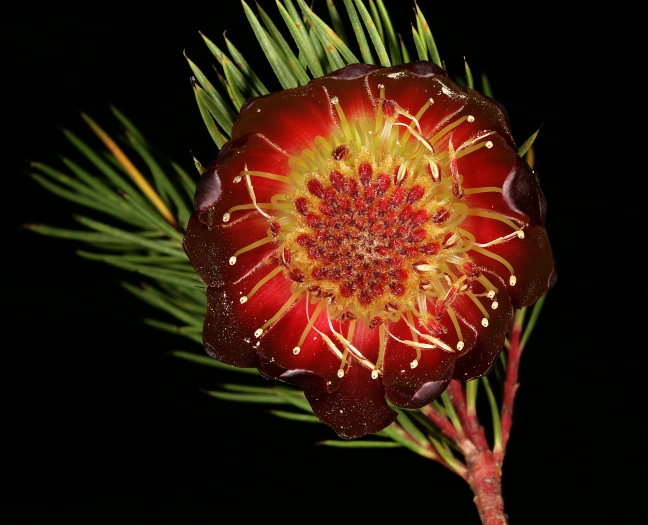Mountain-Rose
(Protea nana)
Mountain-Rose (Protea nana)
/
/

SAplants
CC BY-SA 4.0
Image By:
SAplants
Recorded By:
Copyright:
CC BY-SA 4.0
Copyright Notice:
Photo by: SAplants | License Type: CC BY-SA 4.0 | License URL: https://creativecommons.org/licenses/by-sa/4.0 | Uploader: SAplants | Publisher: Wikimedia Commons | Title: Protea_nana_1DS-II_1-9807.jpg | Notes: == Summary == {{Information |Description=The bilaterally symmetric flowers of ''Prunella vulgaris''. Flowers like these a typical in the [[Lamiaceae]] family. |Source=JIM CONRAD'S NATURALIST NEWSLETTER. Issued from the Siskiyou Mountains west of Grants Pa |














Estimated Native Range
Summary
Protea nana, commonly known as Mountain-Rose, is an evergreen shrub native to the fynbos region of Southwestern South Africa, characterized by heathland, shrubland, and renosterveld. It typically grows to a height of 1.3 meters and adopts a rounded, highly branched form. The branches, initially green, turn red in their second season and eventually mature to brown. This species is known for its midwinter to early summer blooms, featuring cup-shaped, pendulous inflorescences with oval-shaped, bright red to crimson bracts that enclose numerous, shorter crimson flowers. Flower color can vary from burgundy to pale green, and the blooms have a yeasty odor. The inflorescences nod in the wind, adding movement to the garden.
Mountain-Rose is valued for its rapid growth and attractive appearance, with a lifespan of up to ten years in cultivation. Its striking inflorescences make it a popular choice for tall containers, slopes, raised embankments, or rock gardens, where its nodding flowers can be appreciated. It thrives in heavy, low-nutrient, well-drained soils and prefers full sun to part shade with low water requirements. While it can be propagated by seed or top cuttings with growth hormones, it is considered a challenging species to grow in ordinary garden conditions. Light pruning can encourage branching and increase flower production. Potential problems include susceptibility to root rot in poorly drained soils and difficulty in transplanting due to its sensitive root system.CC BY-SA 4.0
Mountain-Rose is valued for its rapid growth and attractive appearance, with a lifespan of up to ten years in cultivation. Its striking inflorescences make it a popular choice for tall containers, slopes, raised embankments, or rock gardens, where its nodding flowers can be appreciated. It thrives in heavy, low-nutrient, well-drained soils and prefers full sun to part shade with low water requirements. While it can be propagated by seed or top cuttings with growth hormones, it is considered a challenging species to grow in ordinary garden conditions. Light pruning can encourage branching and increase flower production. Potential problems include susceptibility to root rot in poorly drained soils and difficulty in transplanting due to its sensitive root system.CC BY-SA 4.0
Plant Description
- Plant Type: Shrub
- Height: 2-3 feet
- Width: 3-5 feet
- Growth Rate: Rapid
- Flower Color: Red
- Flowering Season: Winter, Spring, Summer
- Leaf Retention: Evergreen
Growth Requirements
- Sun: Full Sun, Part Shade
- Water: Low
- Drainage: Medium, Fast
Common Uses
Bee Garden, Bird Garden, Butterfly Garden, Drought Tolerant, Hummingbird Garden, Low Maintenance, Showy Flowers
Natural Habitat
Native to the fynbos region of Southwestern South Africa
Other Names
Common Names: Mountain Rose, Mountain-Rose Sugarbush
Scientific Names: , Protea nana, Protea rosacea, Erodendrum acuifolium, Erodendrum acutifolium, Leucadendron nanum, Leucadendron pinifolium, Protea acuifolia, Protea acutifolia, Scolymocephalus nanus,
GBIF Accepted Name: Protea nana (P.J.Bergius) Thunb.